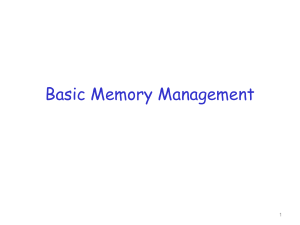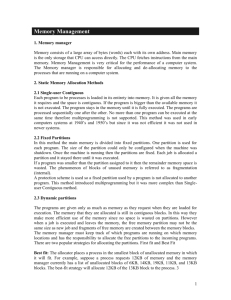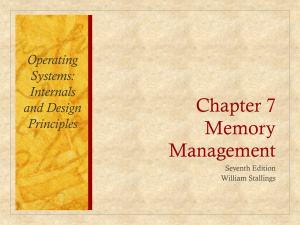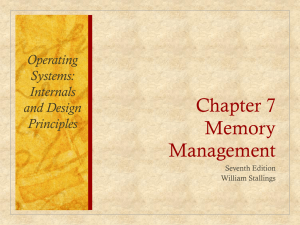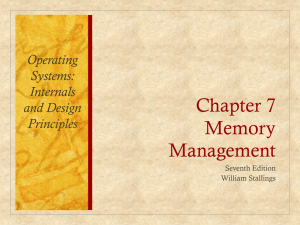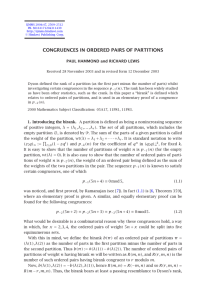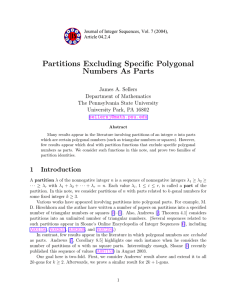Memory Management ()
advertisement
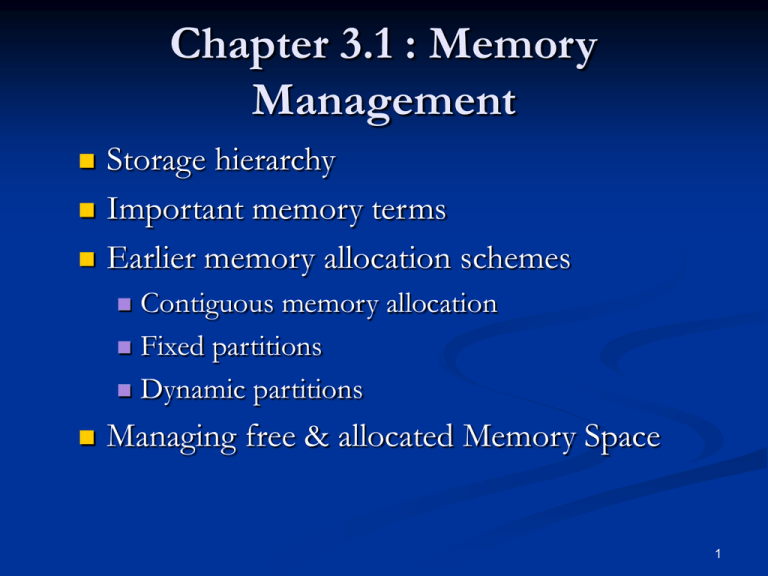
Chapter 3.1 : Memory Management Storage hierarchy Important memory terms Earlier memory allocation schemes Contiguous memory allocation Fixed partitions Dynamic partitions Managing free & allocated Memory Space 1 Storage Hierarchy Main Memory • Cache on Chip (internal cache) • External Cache memory • RAM Secondary Storage Access time decreases Capacity decreases • Hard Disk Tertiary Storage • CD ROM • Floppy • Tape Cost increases 2 Important Memory Terms Term Meaning Contiguous Stored in consecutive memory addresses NOT stored in consecutive memory addresses Memory area limited to actual physical RAM Logical memory area created using a combination of RAM and hard disk What software thinks What hardware knows Smallest amount of information transferred by a disk Program tend to access memory within some localized area Splitting of memory into little bits Non-contiguous Real memory Virtual memory Logical Physical Block Principle of locality Fragmentation 3 Contiguous Memory Allocation OS & drivers User Program After loading OS, the rest of the memory is available for user program Size of user program is fixed by available memory Use of overlays for larger programs 4 Dos Memory Layout 16MB Extended Memory 1M+64KB HMA 1MB Upper Memory Area 640KB Conventional Memory Buffer cache, RAM Disk, Memory for protected mode OS I/O boards, ROMs, MS-DOS and Device drivers MS-DOS, Device drivers, programs 0 5 Basic Memory Management (Monoprogramming) Three simple ways of organizing memory - an operating system with one user process 6 Multiprogramming with Fixed Partitions OS Process 1 F r a g m e n t Partition 1 Process 2 Partition 2 F r a g m e n t Process 3 F r a g m e n t Partition 3 Partition numbers and sizes (equal or unequal) are set by operator at system start up based on workload statistics Used by IBM’s MFT (Multiprogramming with a Fixed Number of Tasks) OS for IBM 360 systems long time ago 7 Modeling Multiprogramming Degree of multiprogramming CPU utilization as a function of number of processes in memory 8 Multiprogramming with Dynamic Partitions Partitions are created at load times OS Memory at system start up OS Process 1 Process 2 Three processes started OS Process 1 Second processes is finished Process 3 Process 3 OS Process 1 Process 3 Process 4 A large fourth process arrives. Process 3 is relocated 9 Problems with Dynamic Partitions Fragmentation occurs due to creation and deletion of memory space at load time Fragmentation is eliminated by relocation Relocation has to be fast to reduce overhead Free (unused) memory has to be managed Allocation of free memory is done by a placement algorithm 10 Question: 11 How to Keep Track of Unused Memory Bit Maps Memory is divided into allocation units of fixed size. A bit map with “0” bits for free and “1” bits for allocated units Memory allocation units: Green - used, Yellow - unused 1 1 0 1 0 1 0 0 1 1 0 1 0 1 Bit map of the above memory 12 How to Keep Track of Unused Memory (Cont.) Linked Lists 1 2 3 4 5 6 7 8 9 10 11 12 13 14 Memory allocation units: Green - used, Yellow - unused U 1 5 F 6 3 U 9 2 F 11 4 Linked list memory map 13 Placement Algorithms First fit Next fit Process is placed in the first hole it can fit in Start searching from the point where the last search has ended and perform first fit Best fit Process is placed in a hole which is closest to the process size 14 Performance Issues Best Fit usually performs the worst, since it leaves behind the smallest possible hole First Fit is simplest to implement and usually fastest and best Next fit is usually a little worse than First Fit 15 Another Allocation scheme: Buddy System Memory is allocated in powers of 2 sized units during load time Initially 1 MB 90 KB request 90KB 128KB 256KB 512KB 300 KB request 90KB 128KB 256KB 300KB 90 KB returned 512KB 300KB 16 Buddy System (Cont.) This method makes de-allocation fast. If a block of size 2k is released then the memory manager checks only the list of 2k holes to merge them into a 2k+1 sized partition Internal fragmentation is caused since memory requests are fitted in 2k sized partitions 17 Problems with Memory Management Techniques so far Unused memory due to fragmentation Memory may contain parts of program which are not used during a run (ie., some routines may not be accessed in that particular run) Process size is limited with the size of physical memory Process needs contiguous space in real memory for execution 18 Can We Get Rid of These Problems? YES! 19


